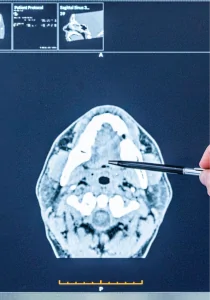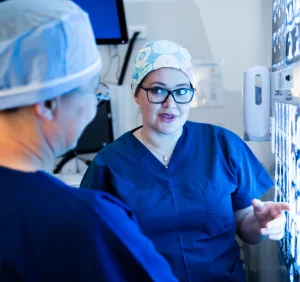
Head & Neck Cancers
What is head and neck cancer?
The term head and neck cancer includes a range of different cancers that originate from the head and neck. Most head and neck cancers originate from a tissue called squamous epithelium which lines the inside of the mouth, nose and throat.
Head and neck cancer includes:
- Nasal and paranasal sinus cancer (cancer originating from the tissue that lines the inside of the nose and sinuses)
- Oral cancer (cancer of the mouth)
- Salivary gland cancer
- Pharynx cancer (cancer of the throat, which is divided into 3 regions – the nasopharynx, the oropharynx and the hypopharynx)
- Larynx cancer (cancer of the voice box)
Cancers that originate from other parts of the head and neck (like brain, eye, thyroid, or oesophagus cancer) are not typically included in the classification of head and neck cancer.
How common is head and neck cancer?
Over 5,000 new cases of head and neck cancer were diagnosed in Australia in 2020, making it Australia’s 7th most common type of cancer.
What causes head and neck cancer?
- Tobacco use. Smoking, chewing of tobacco or the use of snuff, is the main risk factor for head and neck cancer. Heavier use increases your risk.
- Alcohol use. Heavy alcohol use, or the combination of alcohol and tobacco use, increases your chance of developing head and neck cancer.
- Infection with Human Papillomavirus (HPV) or Epstein-Barr virus (EBV)
- Prolonged inhalation exposure to certain dusts or chemicals.
Head and neck cancer is most often diagnosed over the age of 40, and is more common in men than in women.

What are the symptoms of head and neck cancer?
The symptoms of head and neck cancer can vary, but may include:
- A lump in the neck
- A sore that does not heal properly
- A white or red patch in the mouth
- Hoarse voice, or speech difficulties
- Lingering sore throat
- Bleeding from the mouth or nose
- Difficulties with chewing, swallowing or opening the mouth
- Painful or blocked ear
- Pain or numbness in the face
- Painful jaw or loose teeth
- Unexplained weight loss
These symptoms do not necessarily mean that you have cancer. However, any persistent symptom should always be checked by your family doctor.

How is head and neck cancer treated?
The treatment of head and neck cancer depends on the location of the cancer and its spread. Many cases of head and neck cancer require surgery. This may be combined with radiation and/or chemotherapy.
Each cancer case should be managed by a Multidisciplinary Head and Neck Cancer treatment team who are extensively trained in the management of this complex disease. Dr Crawford is a member of the St Vincent’s Head and Neck Multidisciplinary Team which sees patients every week at the Kinghorn Cancer Care Centre in Darlinghurst. This world-class clinic aims to provide patients with individualised care ensuring that you receive the optimal treatment pathway for your individual situation. Patient centred-care also means that you are actively involved in your treatment plan.
What is the prognosis of head and neck cancer?
The prognosis of head and neck cancer depends on how far the cancer has spread, and the nature of the cancer cells. In Australia, 71% of people diagnosed with head and neck cancer are still living 5 years after diagnosis.
Dr Julia Crawford is committed to comprehensive, evidence-based care that optimises your health and wellbeing regardless of the nature or stage of your illness, and utilises the latest treatment modalities to manage her patients who have developed head and neck cancer.
If your family doctor suspects that you may have head and neck cancer, please arrange for a referral and call our practice on 02 8319 9434 to arrange for a consultation with Dr Crawford.
